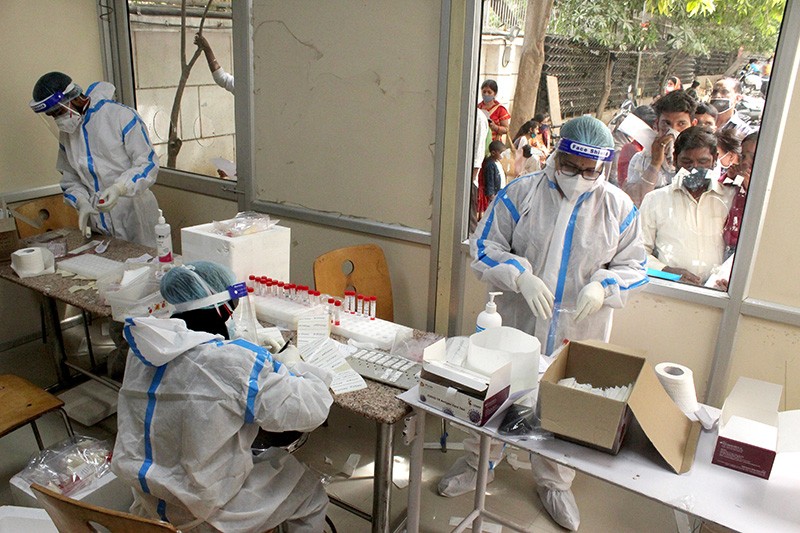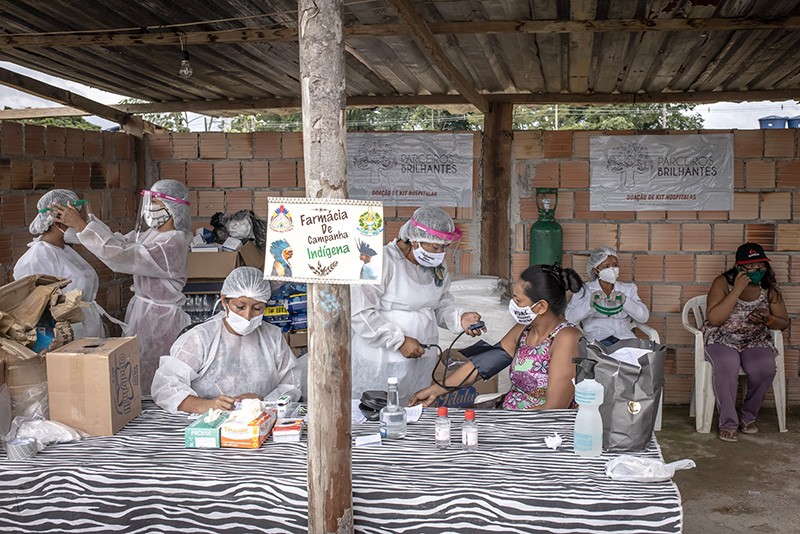The biggest concern is big countries with huge numbers of infections like Brazil, which has weak healthcare systems and the US, where ideological pressure to relax restrictions may combine to instigate another round of the virus. JL
Smrity Mallapati reports in Nature:
An epidemiologist is optimistic the pandemic peaked in January. On 11 January, a record of almost 740,000 new cases of COVID-19 were reported globally, followed 2 weeks later by a record of 14,400 deaths in a single day. From that climax, the numbers fell continuously until 20 February, when 360,000 new cases and 9,500 deaths were recorded globally. The drop is partly the result of a large number of people having already been infected. This is happening in dense urban settings, and badly impacted nations, including India and Mexico. Other countries where larger proportions of the population are still susceptible to the disease - China, Singapore and South Korea - have had success with lockdownsHas the world hit peak COVID-19? It’s a question scientists are beginning to ask as global case figures tumble and mass vaccination efforts gather speed. But a plethora of new variants that threaten to circumvent vaccines and existing natural immunity mean it’s too soon to be sure, say researchers.
“The early evidence is encouraging, but the possibility of variants escaping pre-existing immunity is a clear and present concern,” says Caitlin Rivers, an epidemiologist at Johns Hopkins University in Baltimore, Maryland. “There are lots of places where population immunity and vaccine coverage is quite low, and those places will remain vulnerable.”
On 11 January, a record of almost 740,000 new cases of COVID-19 were reported globally (see ‘The rise and fall of COVID-19’), followed 2 weeks later by a record of more than 14,400 deaths in a single day. From that climax, the numbers fell continuously until 20 February, when about 360,000 new cases and fewer than 9,500 deaths were recorded globally.
The drop in cases and deaths comes as vaccination programmes have been rolling out worldwide. As of 16 March, almost 90 million people had been fully vaccinated against COVID-19, according to national reporting, and about 390 million doses had been administered.
Establishing whether the pandemic has passed its peak is important for assessing the risk of outbreaks and for deciding when to lift restrictions. “It’s the million-dollar question,” says Rachel Baker, an epidemiologist at Princeton University in New Jersey.
Numerous uncertainties
Ramanan Laxminarayan, an epidemiologist at Princeton University but based in New Delhi, India, is optimistic that the pandemic peaked in January. More waves are possible, and they might even reach new regional highs. But in terms of new cases and deaths globally, “the worst is behind us”, he argues.
The drop, Laxminarayan suspects, is partly the result of a large number of people having already been infected. With fewer hosts to infect, the spread of the virus has slowed, he says. This is happening in dense urban settings, such as New York City, and badly impacted nations, including India and Mexico. “These places have already gone through the bulk of the epidemic.”
Other countries, Laxminarayan adds, where larger proportions of the population are still susceptible to the disease — for example, China, Singapore and South Korea — have had more success with lockdowns and other public-health measures, and are likely to continue using them to control future outbreaks.
But some researchers urge caution when interpreting global trends. They point to blind spots in our understanding of the pandemic’s toll and the length of protection against reinfection, as well as the unpredictability of viral biology and people’s behaviour. Global cases have already started to slightly rise again since late February, and the daily number of new cases is currently hovering around 438,000.
“There remain far too many uncertainties to be able to say that the peak has passed,” says Henrik Salje, an infectious-disease epidemiologist at the University of Cambridge, UK.
Natural immunity
Researchers who argue that global case numbers are unlikely to ever hit January’s peak again point to studies that try to reveal the true scale of infection in some parts of the world.
Laxminarayan’s assessment, for example, relies heavily on data from nations and regions where researchers have tested people’s blood for evidence of past SARS-CoV-2 infection. These surveys help to uncover the hidden scale of outbreaks by including asymptomatic people who are overlooked in official counts based on testing.
In India, for example, an as-yet-unpublished nationwide survey of more than 28,000 people in late December and early January estimated that 22% of those aged 10 and older had already been infected. That figure exceeds 40% in megacities such as New Delhi and Mumbai, says Manoj Murhekar, an epidemiologist and director of the National Institute of Epidemiology in Chennai who is one of the researchers behind the work.
He thinks this means that India probably won’t return to the peak of about 100,000 new daily cases, seen in September. But more than three quarters of the population is still susceptible to infection, meaning Indians “can’t become complacent”, adds Murhekar.
Lockdown effect
Elsewhere in the world, populations have not reached the levels of natural immunity seen in India’s megacities, and the fall in cases since late January has instead been driven by lockdowns and social distancing.
For example, a meta-analysis1 of antibody studies, published in The Lancet on 8 March, found that India had one of the highest percentages of antibody prevalence in the general population of any country included in the analysis — with about 20% of people testing positive for antibodies against SARS-CoV-2 — but estimates reached as low as 7% in the Americas, 5% in Europe and 2% in western-Pacific nations. People who develop some immunity to SARS-CoV-2 are thought to be protected from severe disease, but researchers do not know how long that protection lasts.
If people in relatively low-prevalence regions start mixing again when restrictions are relaxed, cases could once more begin to rise, researchers warn.
And what happens in the United States — which accounts for almost a quarter of all recorded worldwide COVID-19 cases to date — will have an important effect on the global trajectory. Although the portion of the US population that’s tested positive for antibodies is lower than that in India, in some states, more than a quarter of the people tested had antibodies against the virus in late January, according to the US Centers for Disease Control and Prevention.
But the overall numbers don’t reflect large variations within communities, says Marm Kilpatrick, an infectious-disease researcher at the University of California, Santa Cruz. Immune protection could explain the fall in some communities where people have been very highly exposed to the virus, but the drop in other communities is probably due to people hunkering down since the holiday period in November and December, says Kilpatrick. As some states lift restrictions, people could start to socialize again, he says.
“It worries me that the US is taking a strong step back from controls,” adds Baker.
A similar situation is unfolding in the United Kingdom and parts of Europe, where plans to reopen risk new waves of infection, says Sebastian Funk, an epidemiologist at the London School of Hygiene & Tropical Medicine. Focusing too much on global numbers overlooks significant variations nationally, he says.
The situation is murkier in many developing nations, where information about numbers of infections is scarce. If sub-Saharan Africa had seen similar surges to those observed in India and the United States, “then we would certainly be over the global peak”, says Joseph Lewnard, an infectious-disease epidemiologist at the University of California, Berkeley. But these surges have not materialized.
Another unknown is how long immunity — either from vaccination or infection — will last, says Salje. If the protection is short-lived, larger outbreaks are possible in the months and years ahead.
Race against time
Emerging variants of the virus are another source of uncertainty. A peak in cases in the United Kingdom followed the emergence and rapid spread of the highly infectious variant B.1.1.7. Funk says some European countries are at high risk of a large wave of the variant, similar to what the United Kingdom experienced late last year. This could already be happening in nations such as Italy, where numbers are again on the rise.
In other places, this might already have happened. There are some signs that a variant called P.1, currently sweeping Brazil, could evade pre-existing immunity and facilitate the virus’s resurgence. These fears are centred around the Brazilian city of Manaus, which COVID-19 hammered last April. Researchers estimate that, by last October, up to 76% of the population could have already been infected and developed immunity, which contributed to a decline in cases.
But hospital admissions due to COVID-19 began to rise rapidly again there in January — exceeding numbers observed last April. The rise coincided with the detection and rapid spread of P.1 in the city. “Manaus is telling us that a second wave is possible,” says Ester Sabino, an infectious-disease researcher at the University of São Paolo in Brazil.
Cases continue to climb across Brazil, and the country could portend an ominous trajectory for other parts of the globe. “The variants of concern have not yet spread around the world, so I believe they could cause damage and increase the death rate again,” says Sabino. “It is too early to say.”
“One thing that gives me comfort here in the US is that that variant is very uncommon,” says Rivers.
“We’re in this race against time,” adds Baker. “Can we vaccinate people fast enough so that we can avoid that future peak from these more transmissible variants?”






















0 comments:
Post a Comment